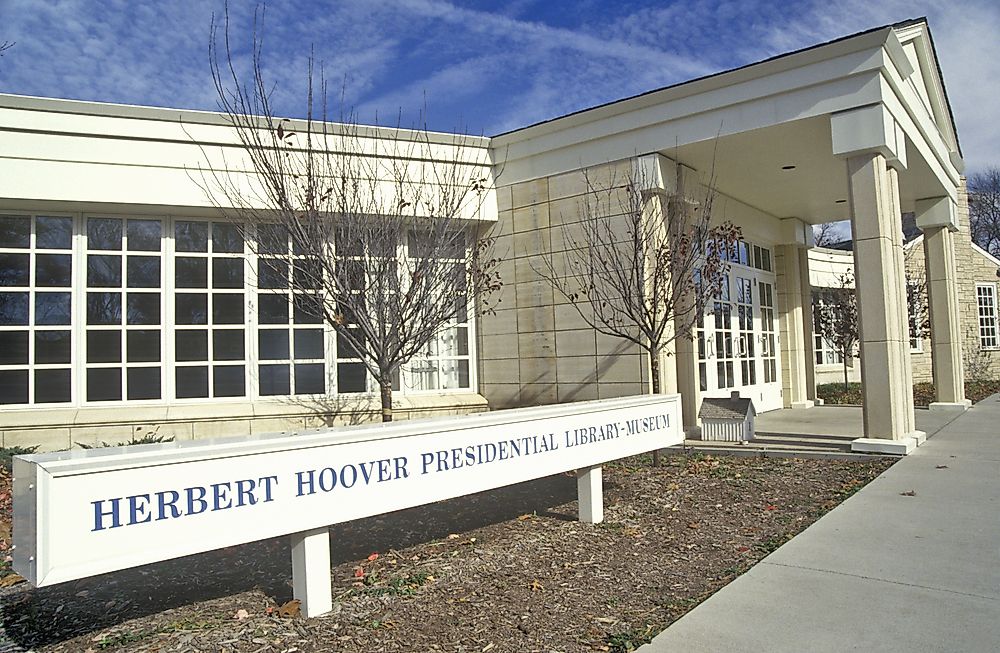Who Was the President During the Great Depression?

The Great Depression was a period of severe worldwide disintegration highlighted in the United States by the Stock Market Crash on what is known as “Black Thursday.” The factors leading to the Depression were many and varied, but the effect was felt across all sectors of the economy. Herbert Hoover was president at the time of the Great Depression.
Before Herbert Hoover's presidency, the early 1920s were characterized by optimism and prosperity. He campaigned for the position mainly promising to continue the nation's prosperity. In 1929 when he became president, the stock market had been soaring at an unprecedented rate with several investors taking advantage of the low-interest rates to purchase stocks on credit which pushed the stock prices even higher. The market bubble burst in October 1929. In about one week the market experienced a drop by almost half of its record highs leading to the loss of billions of dollars by investors.
Early Containment Strategies
In the period after the crash, President Hoover sought to contain the panic from spreading to all sectors of the economy. Some of his early containment moves included the summoning of business leaders to the White House to secure promises on the maintaining of wages, a product of the Hoover economic theory which prescribed that financial losses should only affect profits and not the employer to maintain consumer spending levels and consequently shorten the downturn. He received commitments on the spending of $1.8 billion on construction and repairs to stimulate employment; he also directed the federal and state governments to increase and expand public works projects in addition to asking Congress for a $160 million tax cut to stimulate the economy. By 1930, his interventionism was beginning to yield praise from various quarters. The government and businesses spent more to stimulate the economy than ever before; however, it continued to drop consumerism and forced various businesses and industries to cut their output and lay off workers. By October 1930, the level of unemployment was rising fast. President Hoover established an Emergency Committee on Employment to coordinate relief programs and formulate ways to boost employment in the Private sector. The depression continued to worsen despite the continued spending on the public sector and a request for the Federal Reserve to increase credit.
1931 To 1932
The economic conditions improved briefly in early 1931, but the collapse of several banks in Europe spread additional panic through the nation's economy leading to further loss of jobs. At this point, most of his programs were criticized for the lack of effectiveness and wastage of resources. In 1932 Hoover created the Reconstruction Finance Corporation (RFC) to give emergency loans to businesses and also signed the Emergency Relief Constriction Act to boost the efforts of the RFC. In the summer of 1932, the economy was beginning to show signs of improvement once again, but he was still heavily criticized he later lost the presidency to Franklin D. Roosevelt. Some historians have argued that he was largely an unlucky president who was forced to bear a crisis that had its genesis in previous administrations.
The End Of The Depression
Franklin D. Roosevelt campaigned on a "New Deal" slogan and in November 1932 he won by a landslide. By the time he took up the presidency, the rate of unemployment was about 25%, and the banking system had nearly collapsed. He signed into law the Emergency Banking Relief Act, which was similar to the Act that Hoover had proposed earlier but failed to sail through Congress. The new Act reduced the panic and to some extent stabilized the financial system. His administration was characterized by bold, experimental ideas aimed at stemming the depression. The Depression persisted and came to an end when World War II stimulated the country's economy through the increase in demand for various commodities including war material.











